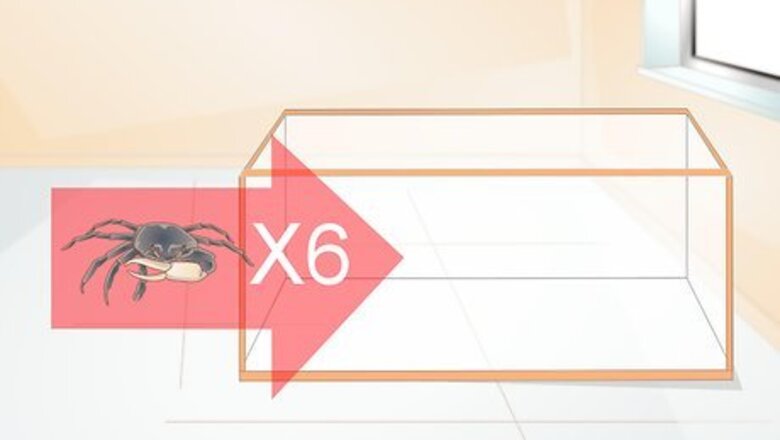
views
Caring for Fiddler Crabs
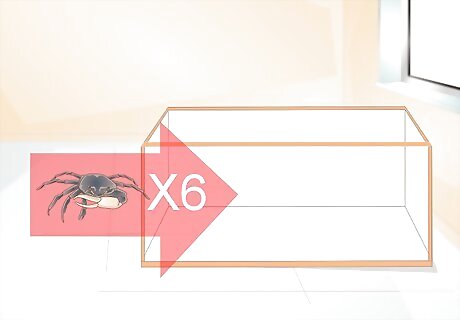
Obtain an aquarium tank. Six crabs can live comfortably in a 3-5 gallon tank. Ensure the tank has a screen at the top to allow the passage of fresh air. If buying your tank secondhand, give it a good rinse and scrubbing with soap, and let it dry before placing your crabs in it.
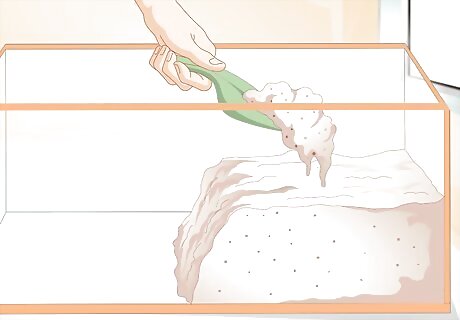
Make the tank a crabitat. Install substrate. Fiddler crabs do well in 4-5 centimeters of sand (though you could add up to 6-8 inches). Add slightly brackish water to the crabitat either in a small bowl pushed down deep into the substrate, or poured directly into one end of the crabitat so that the substrate slopes down into the water at that end. Slightly brackish water should be made using special aquarium salt, rock salt, or another noniodized salt. Do not use regular table salt, as it contains iodine, which the crabs don't like. Mix the brackish water to a salinity of about 30 parts per thousand. Follow the salt's directions to obtain the desired concentration.
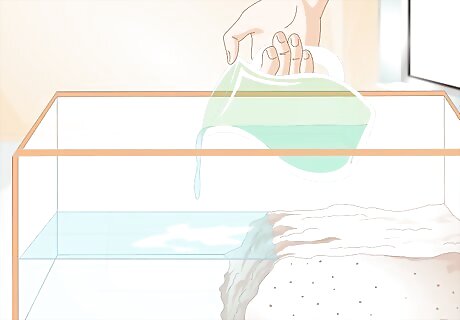
Divide your tank in half between land and water. The easiest way is to dump substrate into one end of the tank and water into the other end, mimicking the natural blending of bodies of water into the littoral (shoreline). Some owners prefer to divide the tank differently, favoring 2/3 land and 1/3 water.
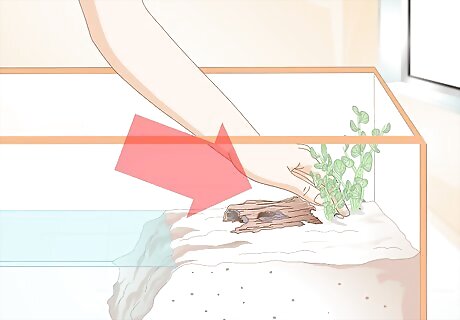
Place some plastic plants, nooks and toys in the tank. Use driftwood and a few rocks to create a natural look and feel. Add 1/4 teaspoon of salt to 1.5 liters of conditioned, dechlorinated water and fill a bowl halfway up with the mixture. Place the bowl with this brackish water in the substrate so that its rim is on the same level as the surface layer of substrate which the crabs walk on. Never use live plants; the crabs will damage them and they might act as vectors for various bugs and mites.
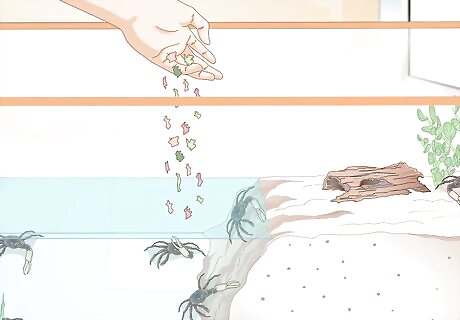
Feed and water your crabs. Fiddler crabs like dried plankton or brine shrimp. Place some into the tank and close the lid. Fiddlers might also enjoy small bits of fruit or veggies if chopped finely. Other foods they enjoy include blanched zucchini, blanched peas, raw or boiled fish, algae wafers, sinking pellets, dried bloodworms, commercial crab food, and krill. Most of these are available at your local pet store. Feed fiddlers sparingly so as not to pollute their water. If you see food has been eaten, add more to the crabitat; if you see food uneaten in the tank after several hours have elapsed, wait before feeding again.
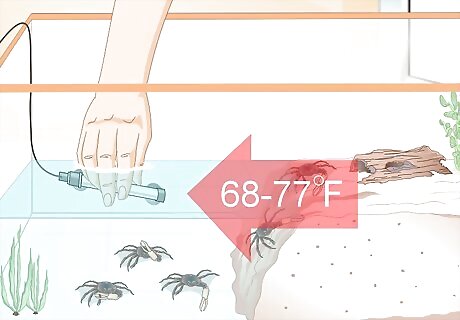
Keep the tank warm. Fiddler crabs prefer a temperature of 68 to 77 °F (20 to 25 °C). Don't place your tank near open windows, doors, or air ducts which might disrupt the tank's microclimate. Conversely, don't place the tank in direct sunlight or too close to a radiator which might fry your crab right in its shell.
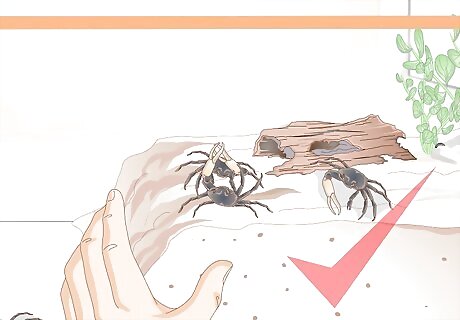
Don't worry about fiddler fights. Males fight to attract females, achieve social dominance, and establish boundaries. If you see crabs pushing or wrestling each other, don't fret. While these conflicts might be aggressive, they are generally not serious. The only thing that will be hurt is the losing crab's ego. The only time for real worry is when a crab is being harassed right after it has molted. At this time, the crab will be fragile for several days. Remove the aggressor if you notice repeated violence against the freshly-molted crab. Crabs have amazing healing properties. Missing claws and legs will eventually regenerate after several successive moltings.
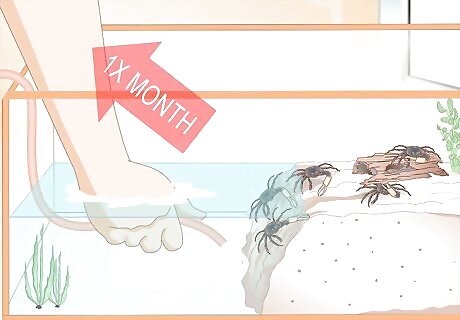
Maintain the environment properly. Water should be changed partially (or entirely) one to two times each month. Make sure that the water you add maintains the salinity at the proper level. Crabs exposed to pure fresh water without salt will, over a long period, die. If the water is cold to the touch, consider adding a basking bulb (in a small tank) or a submersible heater (in a larger tank).
Caring for Hermit Crabs
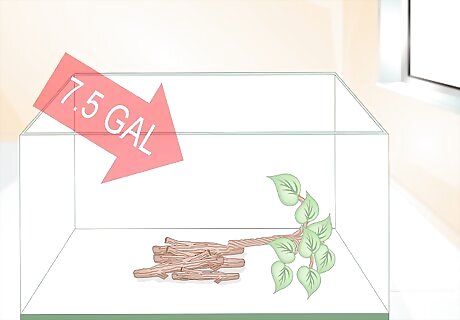
Obtain a habitat of an appropriate size. A terrarium or aquarium with a strong lid is the ideal container for your pet hermit crab. Allocate 2.5 gallons of space per crab. So if you have three hermit crabs, you'll want a tank which is at least 7.5 gallons in size, and will probably want to spring for a ten-gallon tank. Decorate your “crabitat” with plastic plants, driftwood, and climbing accessories which the crabs can clamber over and hide beneath.
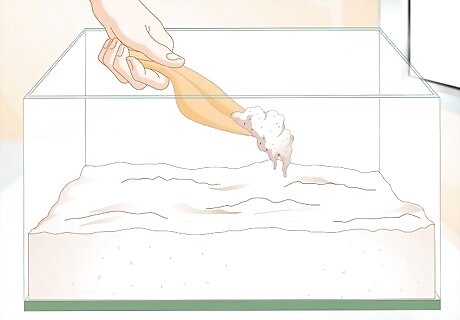
Provide an adequate substrate. Substrates which are easy to clean like sand, crushed coral, or coconut fiber are good choices. Hermit crabs also thrive in a sand/earth mix. The depth of the substrate should be about 2-3 inches deep so that the crabs can dig just as they would in the wild.
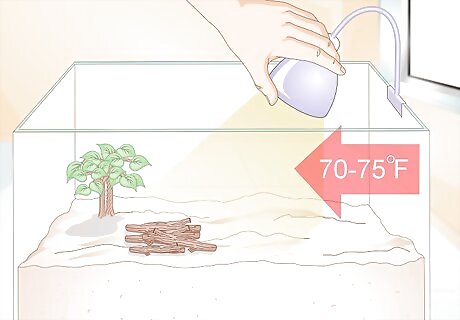
Heat your tank adequately. “Hermies” need to be at about 70–75 °F (21–24 °C). Install a nocturnal heat lamp or an under-tank heater to ensure your crabbies don't freeze. If using the heater, provide at least one inch of substrate so they don't get too toasty. Mist the terrarium occasionally with a fine spray of dechlorinated, distilled water, or install a terrarium humidifier set to 50-80% humidity. You can use a hygrometer to monitor humidity levels. Check the temperature and humidity levels each day. Substrate should be at least two to three inches deep and may be of gravel or fine reptile bark bedding, which better maintains the appropriate humidity levels.
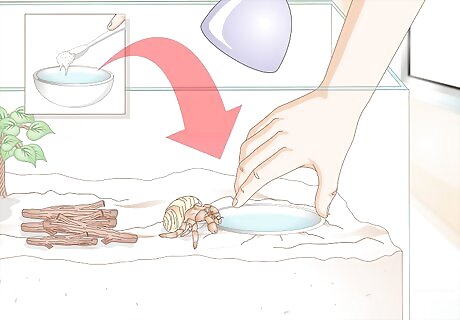
Make your hermies feel at home. Obtain an aquarium salt mix and combine it with dechlorinated water. Get a small bowl with a lip which angles out and fill it with the water mixture. Place it in the substrate so that the lip is even with the top of the substrate upon which the crabs walk. This will mimic the shoreline around which crabs live in the wild.
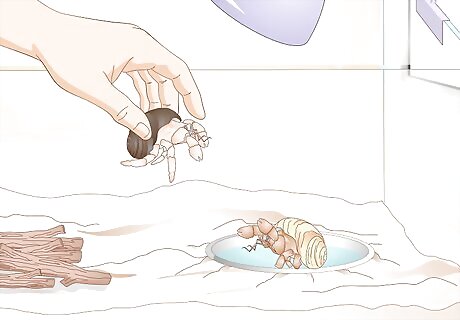
Give your hermit crab some friends. Hermies are social creatures and like living with others of their own kind. When your hermie is with another, you might observe them crawling about together and interacting. Hermit crabs cannot mate in captivity so don't worry about trying to separate the sexes. Hermies may croak or chirp when squabbling with another crab. The sound is natural, so don't worry.
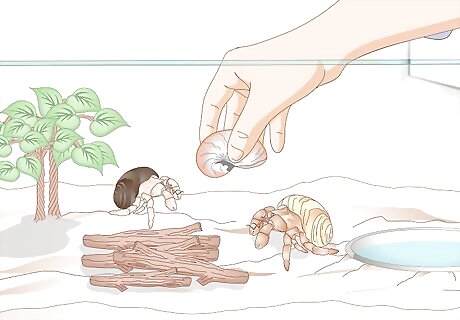
Make shell options available. In the wild, hermit crabs use snail shells for protection. In captivity, though, hermit crabs will need a shell provided. Crabs do not have a regular biological schedule with which you can determine how often they'll change their shells. Some might change shells several times a week, others might change a few times a month. No matter what, though, ensure you have shells of different sizes available for the crab to choose from. A shell's opening should be about 1/8 inch larger around than the width of the crab's large claw. Boil all shells before introducing them to the crabitat. This will wash off any lingering odor which the crab finds unpleasant.
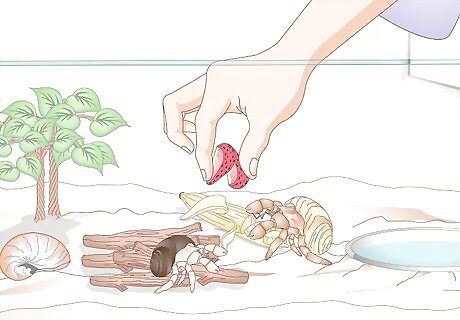
Provide food. Hermit crabs are omnivorous and eat a wide variety of things. They like fruits, veggies, leaves, and insects. Their diet should chiefly consist of commercially available pet crab food. Crab food offers a nutritious blend of vitamin enriched bits to keep your crabs healthy. You can, occasionally, give treats to your crab like raisins, honey, and peanut butter. In order to prevent the crabs from burying their food in the substrate, offer fresh food in a separate container outside of tank. When you want to give the crabs something fresh, remove them to a separate space -- another tank, or a small cardboard box with a towel on the bottom -- and let them eat. This will ensure their tank remains clean. Crabs can go many days without eating. While molting, crabs may not eat for a month. If you see your molting crab not eating, don't worry.
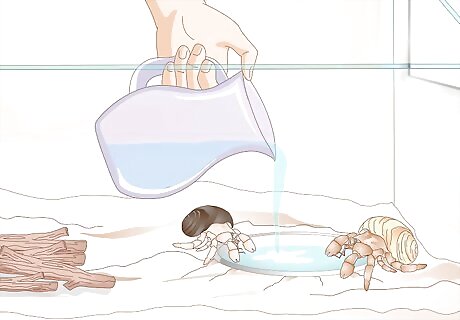
Provide water. Give your crabs fresh, chlorine-free, distilled water each day in a small bowl with an outwardly-angled lip. Place the bowl deep down in the substrate so that the top edge of the bowl and the top layer of the substrate (upon which the crabs walk) are even.
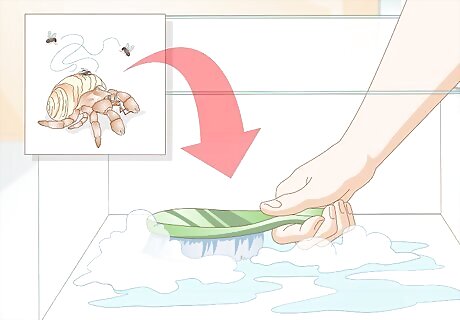
Minimize pests. If you see small bugs crawling on your crab's back, or gnats flying about within the tank, your crab has developed an infestation of pests. To solve this, remove all your crabs to another temporary tank or safe location like a soft towel in your tub or in a cardboard box, then dump all your old substrate out. Rinse and scrub the tank vigorously with water, paying attention to the corners where mites and gnats like to hide. After it dries, use the vacuum cleaner hose to suck any dirt and gunk out of the tank which might remain. Next, sterilize all the tank decor and extra shells by boiling them for about five minutes in water. If you have wood or rocks, sterilize them by putting them in the microwave for about 2 minutes. Be sure to watch the wood carefully to ensure it doesn't catch fire. Install new substrate, replace the crab toys, and put the crabs back in the tank. Instead of throwing out and buying new substrate, you could remove all substrate and bake it in a baking sheet at 300 °F (149 °C) for 30 minutes. Prevent future mite outbreaks by removing uneaten food scraps and don't introduce live plants into the crabitat, since they may act as a vector for mites and bugs to enter. Don't buy crabs from beachside stands or mall kiosks. Crabs at these places are likely not being cared for properly, and are often left exposed to direct sunlight, heat, and cold, and live in crowded conditions where mites and bugs thrive.
Caring for Halloween Crabs and Rainbow Land Crabs
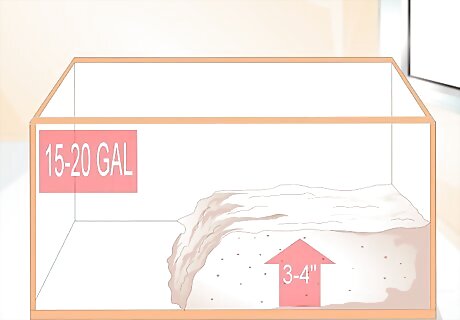
Provide a comfortable environment. The Halloween or rainbow land crab's ideal temperature is around 70 degrees Fahrenheit. An aquarium tank between 15 and 20 gallons in size is adequate for either species. Use heating pads beneath the tank to maintain the temperature, and ensure the substrate provides adequate insulation against direct heat. The substrate should be of aquarium or reptile sand three to four inches deep.
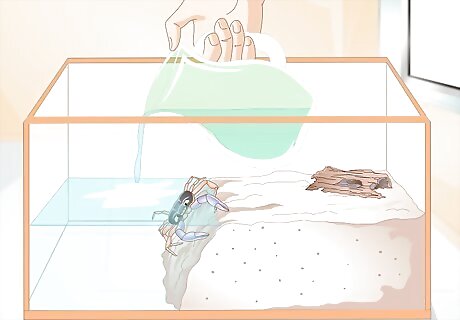
Provide water for your crabs. Rainbow land and Halloween crabs are freshwater crabs, and don't require saltwater. Ensure the water is dechlorinated; spring water is an ideal choice. After covering 2/3 of the tank with substrate, pour water into the remaining 1/3 of the tank. Form a dam where the water meets the land with a long piece or pieces of driftwood. This will help the substrate retain its shape and not collapse on crabs' burrows. Besides driftwood, give your crabs plastic plants, castles, and other climbable aquarium objects to explore.
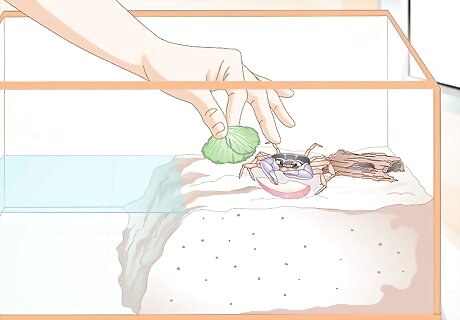
Feed your crabs. Rainbow land and Halloween crabs have diets almost identical to those of the hermit crab. You can feed them fish food, raw fish, and miscellaneous fruits and veggies like apples and potatoes. Ensure your crabs get enough calcium. Cuttlefish bone can be nibbled on for extra calcium, and commercially available calcium supplements can be sprinkled on fresh foods before you serve them to your crabs.
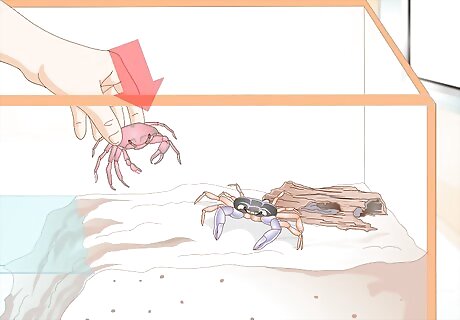
Give your crab some friends. Land crabs are best in pairs rather than large colonies like some other species of crab. Too many crabs can lead to fighting. The more crabs you have in the crabitat, the larger it needs to be. For instance, if your tank was five gallons and housed two crabs, you'll need to upgrade to a ten-gallon tank if you want to bring the total number of crabs in your family up to four.


















Comments
0 comment